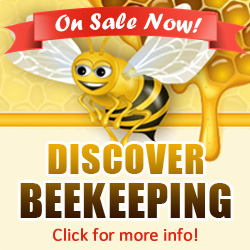Starving to death is surely a horrible way to die, and who is not to say that a beekeeper who allows his bees to enter the winter without enough food for them to make it through the winter is not some kind of idiot? In most cases, a colony of bees needs about 70 pounds of honey, 14 capped deep frames, or 21 capped medium frames, to make it from now to April. Do your colonies have that much stores on board?
For the benefit of both beginners and experienced beekeepers, let me review how to feed your bees now that it is October, when there could be severe robbing on a flight day. This is NOT the time to feed 1:1 thin sugar syrup, but the bees need sugar syrup similar to honey which is 2:1 heavy syrup, 2 pounds of sugar dissolved in 1 pint of water. That is so concentrated that it is difficult to get 2 pounds of sugar dissolved in any heated water unless the water is BOILING. Further, you dare not try to add sugar to boiling water while it is on the stove because you will probably burn the sugar and caramelize it like making fudge, which will make bees SICK. A good beekeeper will use a thermometer, dissolve 1 pound of sugar in a pint of hot water, bring that solution to a BOIL at 212°F, and then add another pound of sugar with a lot of stirring. (A real pain in the fanny, but so is anything that is of value). Those are the basic formula and rules.
What type of feeder are you going to use? There are basically 5 different types of feeders, but I personally think an upside down glass jar or pail is the ONLY one to use because there are far too many problems with any of the other 4 types. I will explain. By my standards, the ENTRANCE feeder is a total joke. It is not big enough, it attracts all kinds of robbers, but mainly bees will NOT leave a warm cluster to go down to the cold front entrance to get feed! It should NEVER be used for anything but firewood. The HIVE TOP feeder is a fine feeder in WARM WEATHER, but is totally useless in cold weather because bees will starve to death rather than break a warm cluster to go to food. There is the BAGGIE feeder that holds one or two gallon plastic bags of sugar syrup, but it suffers the same complaint as the Hive Top feeder that bees will not leave a warm cluster to travel several inches to the bags of sugar syrup. Lastly, there is the DIVISION BOARD feeder which is the worst of all feeders for use in cold weather; because the beekeeper has to totally open the hive to either inspect or refill the feeder, if it is warm enough for the bees to go to the feeder, many bees drown in the syrup, and like the Entrance, Hive Top, and Baggie feeders, bees will not leave a warm cluster and travel several inches to the Division Board feeder in cold weather.
Go to a deli and ask the owner for empty gallon, GLASS jars that held dill pickles, pigs feet, mustard, or potato salad. He trashes them, but give him a jar of your honey and he will save them for you. Why GLASS, and not PLASTIC? When turned upside down, the weight of the sugar syrup tends to cause the plastic shape to collapse, and suddenly the syrup runs into the hive like “dumping a pail of water”. Drill about 4 holes in the jar lid using a bit no larger than 1/16″ or 3/32″. A hole 1/8″ is too large and the syrup might run all over the bees, which will kill them if clustered. If there is no emergency for you to feed, you simply invert the gallon jar over the hole in the inner cover. I put two little sticks, about 1/4″ in diameter, near either end of the inner cover hole ON TOP OF THE FRAMES, so that the weight of the jug of sugar syrup can’t bend the inner cover down on top of the frames below it. If you need to give the bees a LOT of syrup in a hurry, do away with the inner cover, and invert 1, 2, 3, or even 4 gallon jugs of syrup directly on top of the 10 frames and surround these jars with an empty deep hive body or 2 medium hive bodies to keep out the wind, rain, or snow. Feeding this way is so easy, because the jars are sitting right on top of the frames that hold the bees and the bees can feed themselves and store away feed without breaking cluster! Just in case you don’t really understand bees “clustering” or the term “tight cluster”: The wing muscles of a honey bee become paralyzed at temperatures below 50°, so when the outside temperature drops below 50°, bees think about “huddling up” to keep warm. When the temperature inside the hive gets down to about 40°, bees begin to cluster together tightly, and won’t even move a distance of just 1-2 inches away from the cluster in fear of losing cluster warmth and becoming even leg paralyzed so they can’t move at all and die. 1-2 inches is not very much distance, and that is very reason that the ENTRANCE feeder, HIVE TOP feeder, BAGGIE feeder, and DIVISION BOARD feeder all FAIL TO FEED BEES when it is cold, because the bees just can’t travel the 5″-6″ from the cluster to these feeders!
Lastly, don’t tell me or others that a cold winter killed your bees, because you are just showing your lack of knowledge about bees. COLD temperatures, not even 60° below zero, killed healthy bees in tests conducted by numerous bee scientists, and this has been well documented in numerous bee books. Winter losses are primarily due to lack of AVAILABLE food, disease, mites (particularly the tracheal mite), death of an old queen, a hive weak in population going into the winter, lack of ventilation and DAMPNESS. Every colony should have an upper entrance at the inner cover level to release the damp exhaled breath of the clustered bees. Don’t think of keeping warmth in a bee hive like keeping warmth in your house. Recently, we have learned that a SCREENED bottom board provides more ventilation and hence better winter protection for bees than the standard wooden bottom board. Talk to the working bee scientists and bee researchers of today if you don’t believe this. Become a student of new things in our CHANGING TIMES.
So, let me be clear, don’t be a fool and let your bees die of starvation, because you were too lazy to feed them! I have given you fair warning because I have seen a lot of light-weight colonies out there that could be saved by feeding heavy sugar syrup in October and November!
I hope you don’t think this article is just the “prattlings of unnecessary beekeeping stuff” and that all these blunt statements are idle talk! All I’m saying is tend to the needs of your bees and if they’re light in stores provide food for them, it will be your JOY to do so as a genuine beekeeper!
Here’s to your success!






what about us who have a rainy season to deal with what kind of home-made feeders can we use.
Hi Anthony, you can feed this way even in a rainy season. If you don’t like the bottle try a plastic bag with a few holes poked in it and put it directly on the frames.
I have a wild bee hive in a large oak tree branch about 15′ off the ground. Is it posible to feed these bees for the winter months?
Hi John, I’ve never actually tried that. Try filling a couple of plastic soda bottles with sugar water, drill some 1/16 holes in the lid, and hang them close to the hive. It won’t work on the coldest of days though…
Really enjoyed the article but wish you had included a picture showing an installed feeder.
Bee your beest.
I cleaned up an old hive in spring to receive a colony from my honey supplier(B)anyway a colony took up residence. So It seemed good as B an very experienced keeper of many hives thought they were a fairly strong colony of mild temperament. He recommended feeding with a plastic top feeder inverted over top board hole. I think its 5L using 4lb of sugar. I gave 2 in October then 1 mid November. Its just now become frosty in the day,in southern England so I went to check the feeder to find it still full.taking your point about it being too far to risk loosing contact with the cluster. Wonder if I put it directly on the top of the frames and cover with a deep super. Will the frame bear the weight?
or best place strips of wide hard-wood first! Doo!I think I just answered my own Question!!?!! WOHo does that make me intelligle
Great article
I am in Portland, OR and went with the baggie approach in early January.
Apparently the baggie leaked and now there are only a handful of live bees visible (in Jan the second level was covered.)
Apparently the moisture did them in. I’ll do a more detailed check tomorrow but, thinking ahead, can I put new bees into that hive?
Thanks!
Hi Amy, you should be able to use that hive again. The bees do an amazing job cleaning things up for you and if you still had a handful of live bees then it sounds like you caught it just in time!
I would like to know if I can use Fruitose sugar to makw t6he Honey syrup to feed the bees. Let me know, thank you. you can send me an email about my question.
Hi Felix, sure HFCS is ok to use. Here’s a detailed discussion about it that you might be interested in reading: HFCS vs Honey
can you put some pictures of the feeder??
Hi Daniel, I added a video from Brushy Mountain that shows all the different styles of feeders. Hope that helps…
I have always loved honeybees and when a large hive fell out of a tree onto my patio earlier this summer, I thought I was doing the right thing by leaving them alone. I’ve recently been advised that they will not make it through the winter in this condition, and I feel just awful. What can I do to give them the best chance for survival? I have pictures that I can send, but I just need help and advice. I’ve been reading your posts and now I realize that putting a wooden box around them (with an ambient heater) is probably useless and even harmful. What can be done quickly with best chance for their survival?
Hi Pam, it’ll be tough to try and save a feral hive this time of the year. It’s really dependent on where you live (the climate) and where they’ve taken up residence and how big the colony is. With all these variables to look at I suggest you sign up over at http://www.beekeepingforums.com (it’s free) and you’ll be able to ask your question while uploading the pictures. You’ll get a lot of opinions from a lot of experienced beekeepers, hopefully some in your area.
bees not eating sugar. They hardly made any honey, fed on loads of sugar last year….not much honey in the hive and not taking sugar. Worried they will starve.